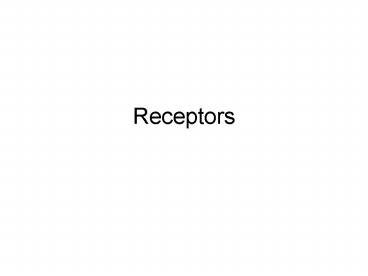Receptors - PowerPoint PPT Presentation
1 / 26
Title:
Receptors
Description:
Receptor binds a messenger leading to an induced fit ... Intercalation prevents replication and transcription. Intercalation inhibits topoisomerase II ... – PowerPoint PPT presentation
Number of Views:26
Avg rating:3.0/5.0
Title: Receptors
1
Receptors
2
Signal transduction
Control of ion channels
3
Signal transduction
- Activation of signal proteins
- Receptor binds a messenger leading to an induced
fit - Opens a binding site for a signal protein
(G-protein) - G-Protein binds, is destabilised then split
4
Signal transduction
- Activation of signal proteins
- G-Protein subunit activates membrane bound enzyme
- Binds to allosteric binding site
- Induced fit results in opening of active site
- Intracellular reaction catalysed
active site (open)
active site (closed)
5
Signal transduction
- Activation of enzyme active site
- Protein serves dual role - receptor plus enzyme
- Receptor binds messenger leading to an induced
fit - Protein changes shape and opens active site
- Reaction catalysed within cell
active site open
6
Nucleic acids as Drug Targets
7
Drugs acting on DNA Drugs acting on
DNA Intercalating agents - Topoisomerase II
- Example Proflavine - Examples
antimalarial agents Alkylating agents Chain
cutters
8
DRUGS ACTING ON DNA
Intercalating agents
- Mechanism of action
- Contain planar aromatic or heteroaromatic ring
systems - Planar systems slip between the layers of nucleic
acid pairs and disrupt the shape of the helix - Preference is often shown for the minor or major
groove - Intercalation prevents replication and
transcription - Intercalation inhibits topoisomerase II
9
DRUGS ACTING ON DNA
Topoisomerase II
- Relieves the strain in the DNA helix by
temporarily cleaving the DNA chain and crossing
an intact strand through the broken strand
- Tyrosine residues in the enzyme are involved in
the chain breaking process - The residues form covalent bonds to DNA
10
DRUGS ACTING ON DNA
Topoisomerase II
- Relieves the strain in the DNA helix by
temporarily cleaving the DNA chain and crossing
an intact strand through the broken strand
- Tyrosine residues in the enzyme are involved in
the chain breaking process - The residues form covalent bonds to DNA
- The enzyme pulls the chains apart to create a gap
- The intact strand of DNA is passed through the gap
11
DRUGS ACTING ON DNA
Topoisomerase II
- Relieves the strain in the DNA helix by
temporarily cleaving the DNA chain and crossing
an intact strand through the broken strand
- Tyrosine residues in the enzyme are involved in
the chain breaking process - The residues form covalent bonds to DNA
- The enzyme pulls the chains apart to create a gap
- The intact strand of DNA is passed through the gap
- The break is resealed
12
DRUGS ACTING ON DNA
Topoisomerase II
- Relieves the strain in the DNA helix by
temporarily cleaving the DNA chain and crossing
an intact strand through the broken strand
- Tyrosine residues in the enzyme are involved in
the chain breaking process - The residues form covalent bonds to DNA
- The enzyme pulls the chains apart to create a gap
- The intact strand of DNA is passed through the gap
- The break is resealed
13
DRUGS ACTING ON DNA
Topoisomerase II
Mechanism of chain cutting
14
DRUGS ACTING ON DNA
Intercalating agents
- Planar tricyclic system
- The amino substituents are protonated and charged
- Used as a topical antibacterial agent in the
second world war - Targets bacterial DNA
- Too toxic for systemic use
15
DRUGS ACTING ON DNA
Intercalating agents
Example - Proflavine
16
DRUGS ACTING ON DNA
Intercalating agents
Examples
Extra binding to sugar phosphate backbone by NH3
Extra binding to sugar phosphate backbone by
cyclic peptide
17
DRUGS ACTING ON DNA
Intercalating agents
Examples- antimalarial agents
18
DRUGS ACTING ON DNA
Alkylating agents
- Contain highly electrophilic groups
- Form covalent bonds to nucleophilic groups in DNA
(e.g. 7-N of guanine) - Prevent replication and transcription
- Useful anti-tumour agents
- Toxic side effects (e.g. alkylation of proteins)
Example Mechlorethamine (nitrogen mustard)
19
DRUGS ACTING ON DNA
Alkylating agents
Cross linking
20
DRUGS ACTING ON DNA
Alkylating agents
Mechanism of action
Crosslinked DNA
21
DRUGS ACTING ON DNA
Alkylating agents
Mechlorethamine analogues
Aromatic ring - e withdrawing effect N is less
nucleophilic Less reactive alkylating
agent Selective for stronger nucleophiles (e.g.
guanine)
Uracil mustard Used vs leukaemia Attached to a
nucleic acid building block Concentrated in fast
growing cells (tumours) Some selectivity
22
DRUGS ACTING ON DNA
Alkylating agents
Binds to DNA in regions rich in guanine units
Intrastrand links rather than interstrand Inhibit
s transcription
Converted to alkylating agent in the body
23
Alkylating agent
Crosslinked DNA
24
DRUGS ACTING ON DNA
Chain cutters
BLEOMYCIN A2 R NHCH2CH2CH2SMe2 BLEOMYCIN
B2 R NHCH2CH2CH2CH2NHC(NH2)NH
- Abstracts H from DNA to generate radicals
- Radicals react with oxygen resulting in chain
cutting - Bleomycin also inhibits repair enzymes
25
DRUGS ACTING ON DNA
Chain cutters
- Generates DNA diradical
- DNA diradical reacts with oxygen
- Results in chain cutting
26
DRUGS ACTING ON DNA
Chain cutters































